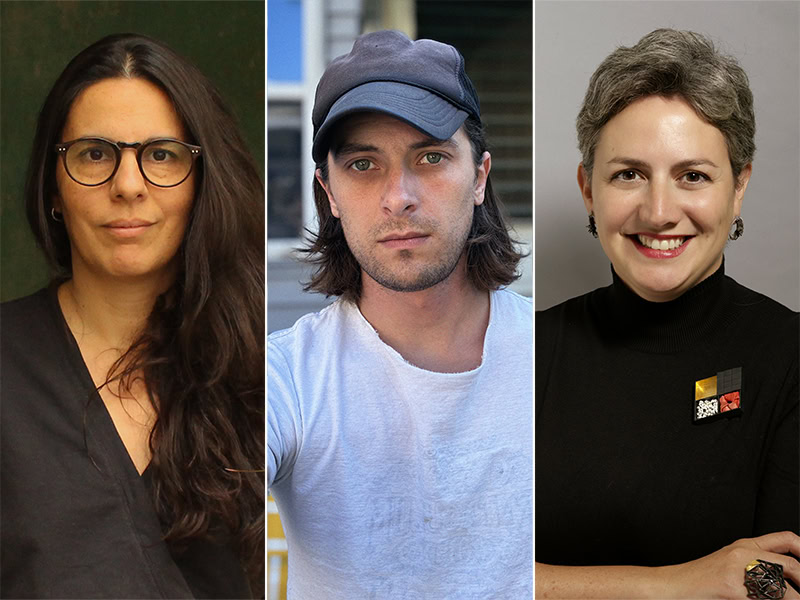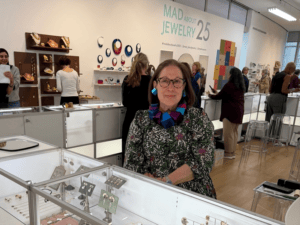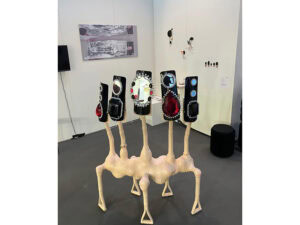- The 2026 AJF Young Artist Award advances the careers of rising jewelry artists aged 35 and under
- The winner receives a prize of US$7,500. Each of four finalists will get US$1,000
- Work by the winner and finalists will be shown in Platina’s booth during Schmuck, in March 2026
- There is a travel allowance of US$1,000 each for the winner and the finalists who travel to Munich to receive their award
Go here to get the guidelines and to apply.

The jury for this 21st award cycle consists of the 2024 Young Artist Award winner Bryan Parnham (his answers below appear in burgundy font); gallerist Thereza Pedrosa (whose answers are colored green); and the artist and educator Jimena Rios (her answers are blue).
Marta Costa Reis: Please explain how you were introduced to contemporary jewelry, and what you’re now doing in relationship to it.
Thereza Pedrosa: I was born into the world of art. My father, Bruno Pedrosa, is an artist with more than 50 years of experience, and since childhood I have followed him to exhibitions, fairs, glassworks in Murano, bronze foundries, ceramic studios, and more. Growing up in Veneto, [an Italian] region rich in culture, I discovered as a teenager the works of artists such as Giampaolo Babetto, Stefano Marchetti, Annamaria Zanella, Stefania Lucchetta, and Carla Riccoboni—artists who opened my eyes to the expressive potential of contemporary jewelry and the individuality behind each creation. At around 17, I asked my father to teach me the basics of soldering, filing, and hammering, and I began making my own pieces. For more than 15 years, alongside my studies in cultural heritage conservation in Venice, I created silver jewelry and collaborated with design stores and museum bookshops, including the Guggenheim in Venice. I stopped when I was expecting my first child, and after the birth of my second daughter, I founded Thereza Pedrosa Gallery. Today, I direct the gallery and curate external projects for museums, books, and artists.
Jimena Rios: I first studied art history in Barcelona, and my introduction to contemporary jewelry came through the old building of Escola Massana. I wanted to study there because you could feel freedom and freshness in the garden of the old hospital. I started, and the best part of that time was the spirit that lived there—the mix of students from all over the world and the strong sense of community they created.
Today, I teach in Argentina, and through my school, Taller Eloi, I try to keep that same spirit alive. It feeds the pieces that emerge from the students’ hands.
Bryan Parnham: I found myself in metalsmithing classes in undergrad, drawn there by the versatility of the tools. In other media I had studied, tools like the potter’s wheel or table saw had their focus in single materials with only subtle variation. You might use terracotta or porcelain; maple or mahogany. Beyond these narrow variations, the tools and curriculum didn’t allow for the wild curiosity of a rural kid newly exposed to a world outside Bedford County, VA, US.
The jewelers saw can cut anything softer than the tool steel it is composed of, and my instructors in the metals program in Craft/Material Studies, at Virginia Commonwealth University, were happy to encourage the use of “alternative materials.” The fact that they were called jewelry classes seemed incidental. We made jewelry, but the lessons were widely applicable. What are the physical properties of the material at hand? How can that material be altered? What is the cultural relevance of that material?
Education by means of thinking about and building jewelry can be an education in economics, physics, chemistry, marketing, engineering, aesthetics, social politics, etc. And with a little imagination it can open doors to philosophy, fine art, design, history, technology, and a dizzying multitude more. Today I’m still engaged with being a student of this under-appreciated field by continuing to participate in its neurotic insistence that what we are all doing is making jewelry. The persistent emphasis on what might be the least consequential aspect of the field could be what makes it all so charming. We call it making jewelry but it’s so much more than this pedestrian nomenclature would suggest.
I’m currently making brooches and beginning the planning stages of a national teaching tour that introduces the use of photopolymer and promotes the dissolution of boundaries between Metalsmithing, Printmaking, Painting, and Photography. (Please make inquiries to bryanparnham@gmail.com if your educational institution wishes to participate.)
The last few years have seen a lot of disruption and uncertainty. What surprises you most in the way younger generations respond to the fast-changing world around them?
Jimena Rios: Where I come from—South America, Argentina—change is a constant. My students have grown up within a landscape of shifting politics and fragile economies, where uncertainty becomes part of everyday life. Adaptability, for them, is almost instinctive. What I find moving is their ability to transform instability into imagination, to create meaning in the midst of movement.
For this generation, jewelry is not an escape from reality but a way to engage with it—a language of resilience and reflection. I’m increasingly drawn to jewelry that doesn’t attempt to beautify the world but to speak to it, trusting in its communicative dimension—not as a manifesto, but as a quiet form of poetry, passed from one generation to the next.
Bryan Parnham: I am entirely unequipped to answer this question as I have few or no acquaintances younger than myself. Even were I to have some connection to younger people, I wouldn’t make the mistake of equating that small group to an accurate representation of such an enormous population as “younger generations.” Still further, I would be greatly embarrassed to venture anything that could be construed as a “Kids these days” style of response. But if I can say what surprises me most about the way anyone responds to change, I would say the following: What surprises me most is that anyone is surprised at all.
Thereza Pedrosa: The world has changed dramatically in recent years, and what strikes me most—something I try to remember for myself—is the remarkable adaptability of younger generations. They move with great agility, capable of shifting direction, turning challenges into opportunities for growth, and embracing transformation with ease. Flexibility is a precious quality, one that we often lose over time, yet it is essential in a world marked by constant political, social, technological, and environmental shifts. I also find it incredibly stimulating to see the themes young artists choose to explore in their research, often reflecting the pulse of our times in unexpected and insightful ways.
What is the single most important conversation for artists to be having today?
Bryan Parnham: A funny one.
There is no singular topic more important than another, but with humor any conversation has a better chance of being heard and appreciated by the parties involved.
Thereza Pedrosa: I don’t believe there is a single conversation that artists should be having. Each artist brings their own background, history, and experiences—their own unique lens through which they interpret life, materials, and meaning. This diversity of perspectives allows us, as viewers, to step outside our comfort zones and engage with ideas we might not have encountered otherwise. For me, this is one of art’s greatest gifts: its power to broaden our horizons, to deepen our understanding, and to open us to new ways of seeing. What matters most is that artists remain authentic to their voice—unafraid to take a position, to evolve, and never to become static in their beliefs or in their artistic research.
Jimena Rios: The most important conversation for artists today is about education and craft. Jewelry is an undeniable form of communication—it carries meaning, memory, and even value. It can be an artwork, yes, but it is also a way of holding others close, of keeping something safe.
More than ever, we need to return to the idea of education as a space of depth, and to craft as a form of knowledge. Young artists should know who came before them, who the gallerists are, and how to work with them responsibly. From that awareness, production will naturally become sustainable, thoughtful, political, and relevant.
Besides grants such as this one, what other ways can young artists be encouraged and supported?
Bryan Parnham: Undoubtedly, generational wealth is the greatest support and encouragement a young artist can hope for. Those of us without such luck are left with today’s regrettable Reaganomic, Go-Fund-Me, “what you need is a grant” system, which provides none of the cultural nutrients of a well-balanced breakfast. Young artists can be encouraged and supported by great ideas, myths, delusions, cognitive bias, loving parents, and enthusiastic friends. These are the reliable means to fuel a willful stubbornness and belief in your path.
Jimena Rios: Grants like this one are essential for young artists, but there are very few. Beyond that, I believe students and new generations need to understand—and we as educators must help them see—the importance of building a career slowly, with patience and consistent work.
At the same time, we need to create a more global space for jewelry, one that moves beyond the Eurocentric framework and opens to cooperative exchanges between different geographies. Only through that diversity can the field stay alive, relevant, and truly connected to the world we live in.
Thereza Pedrosa: Recognition is important at every stage of an artist’s career—from emerging to mid-career to established artists who have dedicated their lives to their art and to mentoring others. That’s why I’m so pleased to contribute, even in a small way [as a juror], to this award, which plays an essential role in encouraging young artists at the beginning of their journey. Beyond grants, I think curators, museum directors, gallerists, authors, and collectors all share a responsibility to champion new voices—by including them in exhibitions alongside established artists, acquiring their works for public and private collections, or featuring them in publications. This kind of support provides not only visibility and financial stability but also a profound sense of encouragement that can make all the difference. Supporting a young artist always involves a degree of risk—you can never be certain how their path will unfold—but taking that risk is part of what it means to truly believe in art.
The opinions expressed here are the authors’ alone, and do not necessarily express those of AJF.
We welcome your comments on our publishing, and will publish letters that engage with our articles in a thoughtful and polite manner. Please submit letters to the editor electronically; do so here. The page on which we publish Letters to the Editor is here.
© 2025 Art Jewelry Forum. All rights reserved. Content may not be reproduced in whole or in part without permission. For reprint permission, contact info (at) artjewelryforum (dot) org





